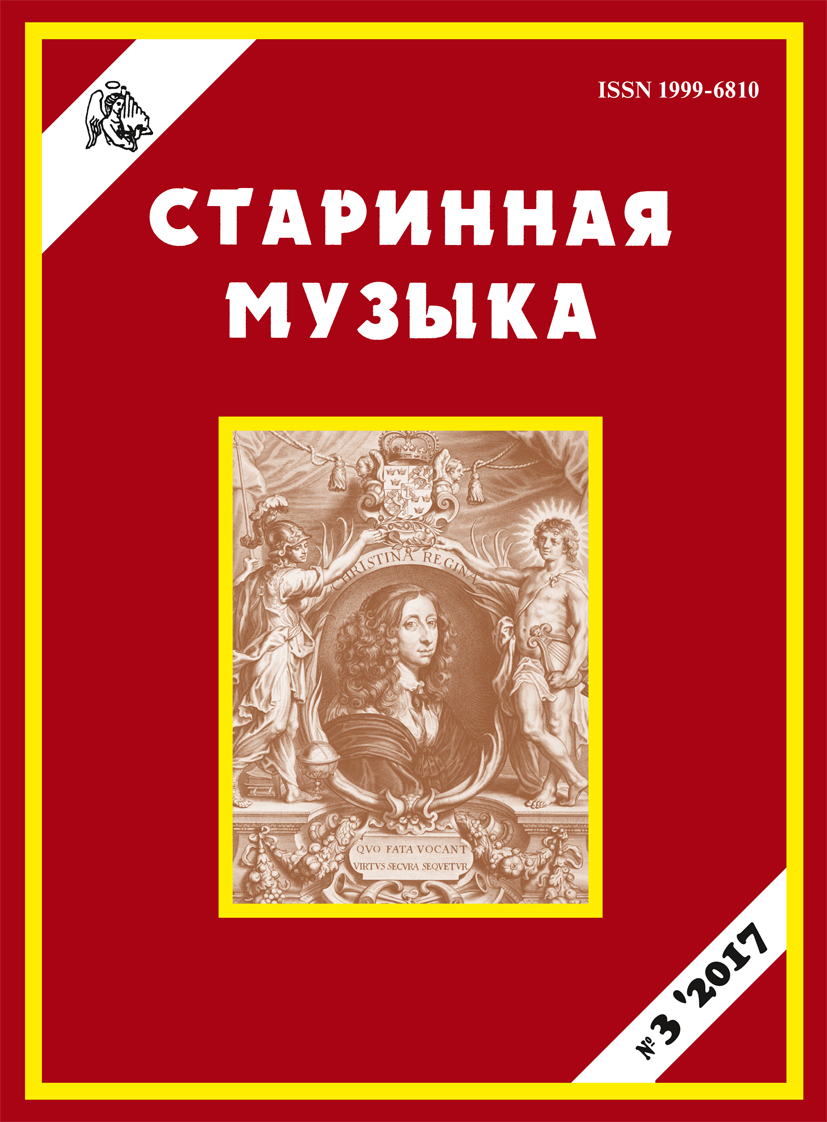№ 3 (77) 2017
Irina Susidko (Professor of Gnessin Russian Academy of Music; Moscow, Russia). Kristina Shvedskaya – pervaya koroleva opery / Christina of Sweden – the First Opera Queen (pp. 1–8)
The article deals with Queen Christina of Sweden (1626–1689) and her role in the development of the opera in the second half of the 17th century. The majority of information is mentioned here on Russian for the first time – for example, the celebration in occasion of Christina’s arrival in Rome (1655), the theatre performances given in her honor, the composers and librettists who collaborated with her. The Christina’s participation in establishing of the first Roman public theater Tordinona is also described in details as well as her influence on the flourishing of private theatrical producing in that time.
Keywords: Christina of Sweden; Barberini family; the Roman Baroque opera; tragicomedy; Tordinona.
Nina Pilipenko (Assistant Professor of Gnessin Russian Academy of Music; Moscow, Russia). Topos srazheniya v evropejskoj opere kontsa 18 – nachala 19 veka: batal’nye szeny i voennye fanfary / Military topic in the European opera of the late 18th – early 19th century: battle scenes and military fanfares (pp. 9–17)
The article deals with the battle scenes in the late 18th – early 19th century opera and the special features of their musical setting. The most opera battles of this period contain fanfare as a basis of the orchestral texture. Fanfares may appear in a characteristic rhythmic pattern, and as solo trumpet calls. These calls have usually practical origins traced back to the actually existing military fanfares. The article discusses some of such fanfare quotations in the opera battle scenes.
Keywords: opera, battle scenes, fanfare, L. Cherubini, J. S. Mayr, F. Schubert.
Elena Ryzhkova (post-graduate student of Ural State Conservatory; Yekaterinburg, Russia). Iz istorii Gabsburgskoy pridvornoy kapelly v period pravleniya Rudolfa II / Habsburg Court Chapel in the reign of Rudolph II (pp. 18–23)
The Habsburg court chapel moving to Prague in the reign of Rudolph II became important event in musical life of Bohemia. The author describes the status of this chapel, its structure, functions, repertoire, leading musicians and administrative board. The special role of Jacob Chimarrheus in management of the chapel is noted.
Keywords: Rudolf II; Habsburg Court Chapel; Rudolphinian Prague; court musicians; Jacob Chimarrhaeus
Zalina Mityukova (post-graduate student of Kazan State Conservatory; Kazan, Russia). Carlo Cotumacci: pravila i printsipy partimenti / Carlo Cotumacci: the rules and principles of partimenti (pp. 24–29)
The article focuses on the 18th century treatise “Principi e Regole di Partimenti…” by Carlo Cotumacci who was the leading master of the Neapolitan partimento tradition. Theoretical part of this work distinguishes it from many other partimenti sources of that time. The treatise presents the Cotumacci’s teaching method and provides with reliable information on the partimento practice.
Keywords: Carlo Cotumacci; partimento; improvisation; Neapolitan school; keyboard music.
Anna Bulycheva (Assistant Professor of Tchaikovsky Moscow State Conservatory; Moscow). Kakoj dolzhna byt’ sovremennaya biografiya / What should an actual biographic study be like? (pp. 30–31)
The paper reviews the new biography of George Frideric Handel written by Larissa Kirillina. This book stands at the junction of scholarly and popular genre, and Handel’s life is described through his works
Keywords: Handel; biography; 18th century music; iconography.


